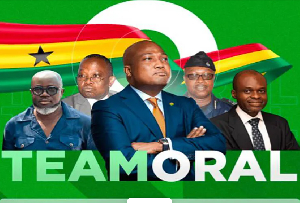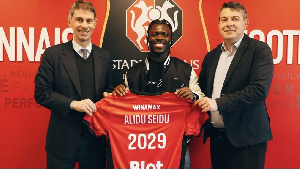Kwame Nkrumah was hardly to be envied as leader of the first African government in 1951. He inherited a health service that was according to medical historian Stephen Addae “curative oriented, favored the south of the country, could handle about 20% of the population, whose organization was clearly outdated and which had a grossly inadequate medical staff consisting mostly of European doctors and a small cadre of auxiliary medical staff.”
Dr. Emmanuel Evans-Anfom, then freshly qualified from the UK and headed home in 1950, vividly captures the moment. “At that time, the move towards independence was at its height…So much had happened…Kwame Nkrumah was in prison as a result of political action, “positive action” and the political fever at home was quite strong. It was also quite clear that the independence which we had all been yearning for was achievable in our lifetime. Frankly, there had been times when none of us at that time felt that we would ever become independent during our lifetime.” Professionals like Evans-Anfom clearly saw the extra responsibility that an independent post-colonial Ghana would thrust on the privileged educated few.
By 1951, only 3 health centers existed in all of rural Gold Coast with preventive medicine virtually non existent. Nkrumah thus accepted the proposals of the Maude Commission of 1952 to expand both the health centers and the Medical Field Units as the most practical way of addressing the health needs of the people. By 1960, the Nkrumah government had increased the number of health centres to 23 with an additional 23 under construction. These centres provided health education, treated minor ailments, and referred major conditions to the nearest district hospitals while enjoying a weekly visit from a medical officer. In addition, in a system reminiscent of modern day CHPS compounds, they had a midwife, a sanitary inspector and a nurse. By 1960, Nkrumah had created doctor-led health teams with jurisdiction over these centers.
Additionally, he radically broadened the scope of the health centres’ work from the Maude Commission’s original proposals. This he did by adopting now established modern public health concepts of providing holistic healthcare through multisectoral collaboration. Nkrumah tasked health centers with improving both the social and health standards of the community thus drafting in officials from the agricultural and education sectors etc Meanwhile the MFU were made of trained supervised medical auxiliaries, some with limited education who could examine slides for trypanosomes and malaria parasites, give injections, do lumbar punctures and clinically recognize guinea worm yaws etc. By 1960, they had achieved “striking success”. Indeed it is widely held that had their pace been kept after 1966, the story of endemic diseases in Ghana would have been significantly different. In 1960, infant mortality, high at 110/1000 but down from the 1915 figure of 350 remains comparable with the somewhat stagnating 2006 rate of 77/1000 live births.
By 1961, it was indisputable that the Nkrumah government’s commitment to a major health reform was total. With no direct out-of-pocket payment at the point of service delivery, health was financed entirely through government tax revenue. Nkrumah engaged the services of an Israeli, Dr. Brachott and tasked him to develop a 10 year plan. Brachott saw and appreciated the urgency: the 40% population increase from 4.8 million in 1948, a 3 fold increase in urbanization in three major cities and increased demand for modern medical care resulting in overcrowded OPDs. Brachott’s plan had three major underpinnings “a rural health service integrated into the system of health facilities; a country-wide hospital plan and a training programme for medical and paramedical personnel.” By 1961, the government had built seven training schools and hostels for nurses, modernized nine hospitals, extended Korle Bu and built a new mental hospital at Ankaful plus 100 bungalows and flats for doctors in the health centres and hospitals. Between 1961-1962 Nkrumah spent three times what he spent between 1957-1960. His policy formulation was clearly evidence-based: typically, while recognizing how key the shortage of professionals was to the plan, he got statistical evidence to prove that Ghana had the manpower resources to make the plan feasible. Also, the need for the new country to start producing its own doctors could not be overstated which is why despite three previous postponements before 1957, Nkrumah was adamant to put up a medical school.
The Ghana Medical School It would not be until 1961 that Nkrumah seriously renewed plans to start a medical school in Accra after Guggisberg’s earlier attempts had been derailed by economic misfortunes and insufficient science students.
Original idea had been that the medical school sited near Legon would be set up with American assistance until President Nkrumah abrogated the agreement at the “eleventh hour” in 1964. Four versions of the reasons accounting for this action have been told: It was said that Nkrumah’s actions were upon the advice of a South African Scientist called Gillman who felt that American medical education was not appropriate for Ghana or that Ghanaians could start their own medical school. A third version had it that an American visitor alerted Nkrumah to the presence of CIA spies among 25 specialist lecturers recruited by American Dean-Designate Cross. Additional accounts were that the President felt the money was being unduly delayed with negotiations which started towards the end of President Eisenhower’s term being suspended during Kennedy’s term. It was however reinstated albeit with slow implementation for which reason Nkrumah was alleged to have said, “The Americans are playing politics with my medical school.”
Subsequently Nkrumah virtually railroaded Ghanaian doctors to start the medical school under the leadership of Dr Charles Odamtten Easmon, then Chief Surgeon at the Korle Bu Hospital whom he cornered at lunch. Easmon, it may be pointed out won a government scholarship to study medicine in Edinburgh (1935), thereby making him the third Gold Coast medical scholar after Oku Ampofo (1933) and Eustace Akwei (1934). He it was who as the first Ghanaian to qualify as a surgeon in 1948, led a team to perform the first heart operation in the early 1960s. Dr Nkrumah then issued a policy directive for the strict utilization of local Ghanaian talent and resources only as part of the Africanisation policy.
The wishes of the Ghana Medical Association for a teaching hospital at Legon separate from the Korle Bu Hospital were rejected. Instead, the Nkrumah government quickly expanded Korle Bu with the addition of four high rise buildings namely Surgical, Medical, Pediatric and Obstetrics Blocks. Reasons adduced included insufficient funds to duplicate the facility, possibility of attracting more qualified doctors to the teaching hospital thus conferring a second rate status on Korle Bu and finally that “in order to instill a sense of socialism, it was essential that students should get into existing conditions rather than into an ‘ivory tower situation’.”
Constrained by staff shortages, Dean-Designate Easmon embarked on an equally ambitious recruitment drive, compelling the likes of Evans-Anfom then pursuing post-graduate education at the University of Edinburgh to abandon their studies mid-stream. Additionally the basic sciences, the foundation for any medical programme was completely bereft of lecturers thereby forcing clinicians to assist. Dr. J.K.M Quartey had to leave his clinical work as a surgeon to set up the Department of Anatomy assisted by the likes of Drs. E.A. Badoe, Evans-Anfom and F. Engmann. Later, Drs Harold Phillips and Andoh would respectively return from Canada and Germany to take charge of Physiology and Biochemistry.
According to Dr. Barnor, “The immediate challenge therefore was how to organize a new curriculum which the local professionals could relate to and teach. At that material time, there were no medical school buildings, no laboratories, no dissection room, no equipment nor books and no trained basic science teachers on the ground. President Nkrumah was supposed to have told the leaders of the profession, ‘you are practicing specialists, surely you could teach medical students to become doctors!’”
By March 1969, the first group graduated with high commendations from British external examiners including Joseph O. Commey, current head of the GHS Council and at the time described as the most distinguished scholar of his class. Almost mentioned is Rev Prof A.S. Ayettey now Chair of Korle Bu Board. Initially viewed with disdain, by the silver jubilee of UGMS in 1987, Easmon would stoutly declare, “We have shown that we can train doctors in Ghana who are acceptable anywhere in the world.” Today, the quality of the doctors trained and their marketability have left many wondering whether the country is now a manufacturing plant for foreign countries? Others have argued against the futility of spending so much to train doctors if similar efforts will not go into retaining them.
This leads us to the formation of the GMA as the first professional association in January 1958 as an amalgamation of Gold Coast Medical Practitioners Union and the Ghana Branch of the British Medical Association. At the time, Nkrumah envisaged the GMA as not only the body to spearhead the welfare interests of doctors but also to be available for consultation on measures to improve healthcare delivery in Ghana. Nkrumah thus declared at inauguration that “I want the GMA to be strong so that the government and the profession can talk to each other and to prosper in the years ahead.”
Not all was rosy however in government-GMA relations. Infact although attempts by the GMA to gain recognition in the Ministry of Health were largely perceived as “unwanted interventions”, it was not until years later before acting upon the Osagyefo’s directives, the Executive Council of the GMA resolved at its 6th AGM, forced and finally got official recognition from the MOH with a file being opened with a liaison officer.
Meanwhile, personal access to the President did not seem to be a problem. Dr. M.A. Barnor, third GMA President tells the story of how on one occasion, President Nkrumah invited the GMA for a meeting at Flagstaff House with accompanying dispatch riders. This meeting in 1963 would eventually culminate in 5 policy initiatives only the last 3 of which saw the light of day: Compulsory offer of 6hours of service a week by private doctors to the State, regulation of fees charged by private doctors and pharmacists, establishment of a Medical and Dental Council to regulate the profession, abolition of all grades and titles of government medical officers and the revision of salaries of specialists and medical officers by increments of between 54-2250 pounds.
These were at the time seen as “unparalleled financial rewards” for which reason the GMA offered to use its own finances to send a delegation to Europe to “acquaint qualified practicing doctors and medical students with first hand information about home as regards the need for more doctors to meet the challenges of independence.” Of course, later, President Nkrumah bore the transportation expenses of the delegation which then took President Barnor and Secretary Boohene to England, Germany, Austria and Ireland where they interacted with over 150 medics, some of whom later returned to contribute to service delivery and medical education.
To quote Stephen Adei, leadership is cause, everything else is effect. The leader voted man of the millennium is doubtless Ghana and Africa’s gift to the free world.
Sodzi Sodzi-Tettey 20th September, 2009
Opinions of Tuesday, 29 September 2009
Columnist: Sodzi-Tettey, Sodzi
Kwame Nkrumah’s Revolutionary Health Platform
Opinions











